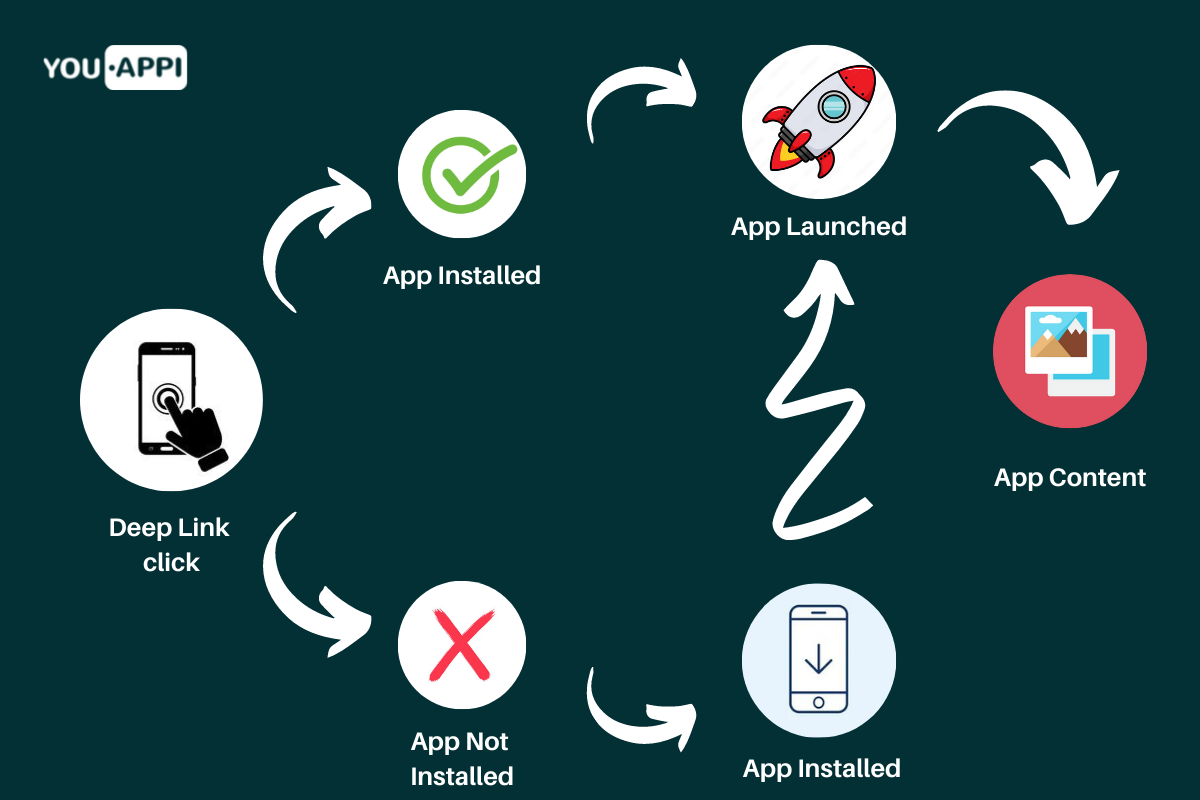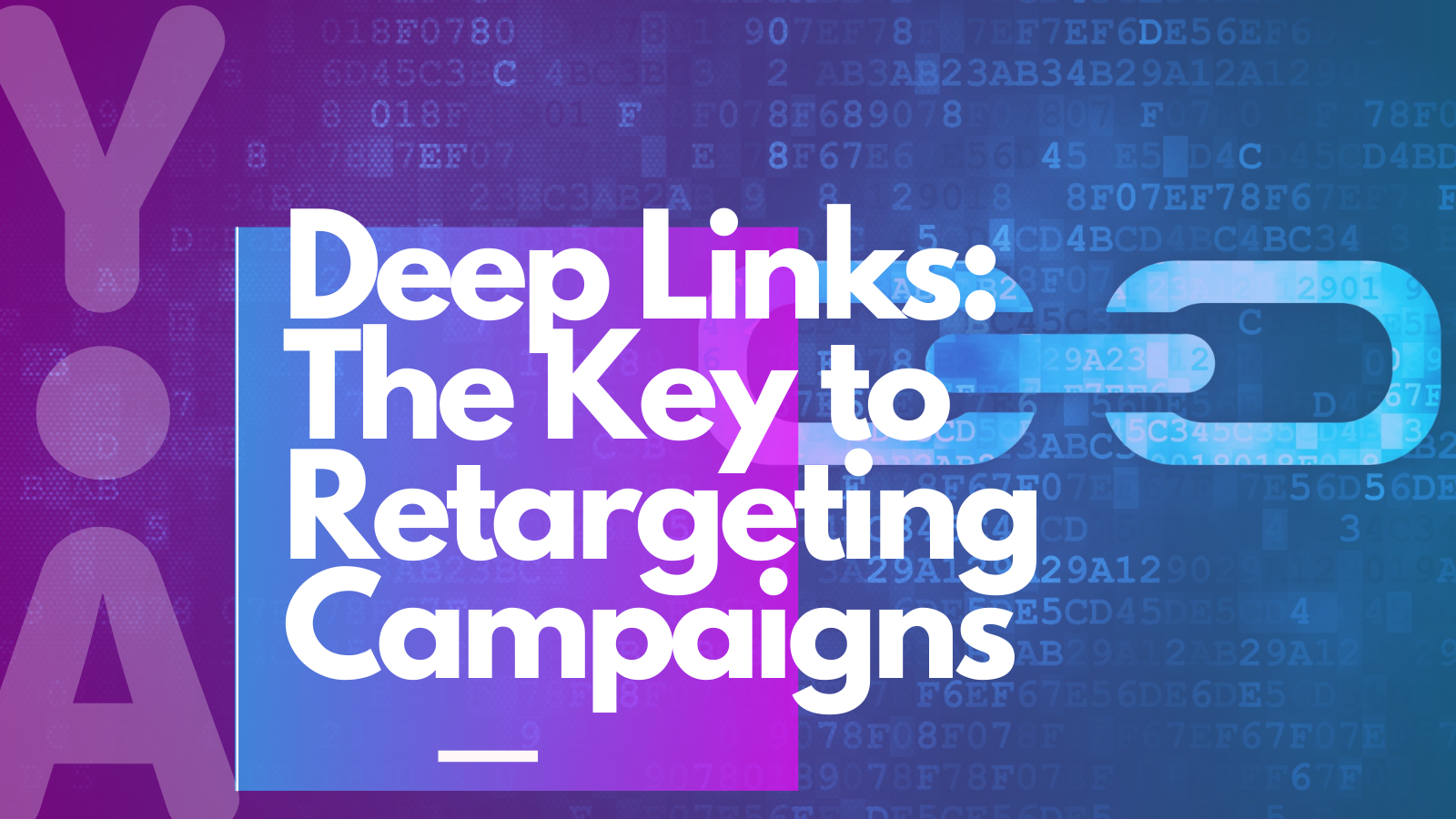Finding a specific location is much easier with directions that clearly and accurately provide steps or a path to follow to get to the desired destination. For example, if you were on your way to Disneyland and asked someone where Splash Mountain is and they gave you directions to the park entrance, that doesn't help you in your search. Links operate in a similar way. Links bring users to specifically locate what they are looking for. Clicking a link and being brought to the homepage of a website doesn’t actually help if you are looking for specific information.
Deep links solve this problem. Deep links are types of links that send users directly to an app, or desired location inside an app, instead of a general location, like a website or homepage. These links can be used to guide users straight to specific locations within the app, depending on the link need and use case, which saves users time and is more efficient than having them search for a particular page themselves. Deep links improve the user journey, and generate a more effective flow to reach the desired destination.
These links are incredibly useful to marketers, to improve the user experience, creating a positive app experience, but also by adding a competitive edge when it comes to retargeting campaigns by reducing churn and increasing conversions.
What are Deep links?
Deep links were created by Apple in 2015 in order to help app developers create a direct line between their mobile app and website. With deep links, user routing is handled directly by the operating system and gives users a seamless experience whether the app is downloaded on a user’s device or not.
Deep linking allows people to click on a link on the web, in an email or text, or in an in-app ad and go directly to specific functionality on a specific screen in an app. This helps mobile marketers create customized experiences that seamlessly continue customer journeys, app onboarding experiences, mobile commerce conversions, and more. Marketers can utilize deep linking in retargeting campaigns in order to guide users directly to the desired destination.

Why are deep links important?
As marketers, the goal is to help user’s find apps or “solutions” to make their lives easier. With deep links, this is a tool to facilitate that process, to get the user from point A to point B with the least amount of resistance. Having the ability to use deep linking to send a user with one click from an ad directly to your app, or to a specific location within the app is extremely beneficial when it comes to retargeting campaigns. Deep links create a seamless user journey, which in turn reduces the likelihood of churn and increases the potential number of conversions.
Retargeting Initiatives:
Mobile retargeting creates value by bringing dormant or lapsed users back into a specific app. Most retargeting campaigns utilize deep link technology, so when a user clicks on the retargeting ad, the messaging and the end location of that link align, allowing the user to be led back into the app or to a specific end point (matching the messaging in the retargeting ad). When a retargeting campaign utilizes deep linking in the user flow strategy, marketers can guide these users to specific pages that are most likely to trigger conversions, creating value through user retention.
Let's break this down a step further. When targeting a user who has not converted to a specific in app event, for example “a fitness apps’ subscription” beyond a free version of the app, a marketer should utilize the deep linking function, with incentive messaging for the retargeting ad to get the user to click and be directly brought into the fitness app to the subscription page to finish their sign up. This eliminates the need for the user to navigate through the app themselves, trying to find and make multiple clicks to subscribe. In another case, if a user has deleted an app, and they have been segmented to be targeted for a reactivation campaign, along with the appropriate creative, messaging, timing and so on, the ad with a deep link will take that user back to the Apple or Google Play Store to encourage them to re-download the app, based on the incentive displayed. This process helps retain users who have dropped off by taking them right back to where they left off or back to the last step in their user journey.
Higher Conversion Rates:
One of the biggest advantages of deep linking is the ability to guide users directly to the app page where you want them to convert. Because there is no need for extra searching within the app, the user experiences a high quality, seamless journey to the desired destination. This means that there is less of an opportunity to break away from the conversion funnel. On average, utilizing deep linking can increase the conversion rate of your app by over 50%.
Deep links drive higher conversion rates because they can be personalized to the user’s interests. Combining deep links with personalized ads is a powerful strategy for increasing conversions and deepening user loyalty. For example, if you're trying to get a specific group of users to engage with your shopping app by showing ads for clothing that is on sale for the summer, you can use deep links to send people directly to that specific retail item, rather than the homepage of your app. The overall improved experience within the app leads to higher engagement. It is much easier to re-engage with an existing user than to acquire a new one.
Reducing Churn:
User churn is a challenge for app developers, defined by user’s simply disengaging from the app, or perhaps deleting the app altogether. Users may have difficulty navigating websites or app interfaces, or perhaps they lack the understanding of the app flow or get confused, lost, or consider the content irrelevant. With so many possible reasons a user could move on from the app, pinpointing a solution and building a strategy around that is how to mitigate this issue. According to a Nielsen Norman Group study, 51 percent of users couldn't find the products they were looking for in ecommerce site searches. By utilizing deep linking, this can remove the guesswork for users, away from scouring the app, searching through pages and images trying to find what they are looking for.
With deep links, users are taken to an exact location within the app, eliminating confusion when it comes to searching for what they need, alleviating potential user churn numbers. For example, for a gaming app, you would want to guide users who have shown interest in playing a specific type of game back to the level they were on when they dropped off. Using deep links to match messaging to the user’s point in their journey is essential. Make sure you are mindful of where you send the user on their journey through deep linking, it should make sense to both your strategy and for the user journey.
Improve User Experience:
Just as you would rather be given directions to the exact location you wanted to go within a theme park, rather than being guided to just the entrance, users prefer to be taken directly to the relevant destination within an app they are interested in or is relevant to the retargeting ad displayed. Instead of the user having to launch the app and then relocate the correct content, level or location to receive the messaging used for a retargeting campaign, they are led directly to the desired page, creating a seamless user experience. Users want to feel like the apps they are using are second nature, and make their lives easier. Creating an appropriate user flow, through deep links, makes for a positive brand/app experience, increasing loyalty through that positive experience.
Takeaways of the Importance of Deep Linking
Deep links are types of links that send users directly to an app, or a point within an app, instead of a general website or page. Deep links save time for users, making it efficient and effective to utilize in the user flow.These links are incredibly useful to marketers, to improve the user experience, but also add a competitive edge when it comes to retargeting campaigns.
- Retargeting Initiatives: Most high impact retargeting campaigns use deep link technology, to direct the user to the target destination to encourage the goal action, encouraging an increase in conversions.
- Higher Conversion Rates: One of the biggest advantages of deep linking is the ability to guide users directly to the app page where you want them to convert. Because there is no need for extra searching within the app, there is less of an opportunity to break away from the conversion funnel. On average, utilizing deep linking can increase the conversion rate of your app by over 50%!
- Reducing Churn: By utilizing deep linking, users are taken to an exact location within the app and are shown relevant content – eliminating confusion when it comes to searching for what they need, alleviating most users from churning away from the app.
- Improve customer experience: Users would prefer to be taken directly to the relevant destination within an app than a general location like the homepage. Deep linking improves the user journey and makes it seamless to find exactly what they are looking for.
Need help leveraging deep links in your next mobile retargeting campaign? YouAppi is here to help. Contact us today to start a conversation!

